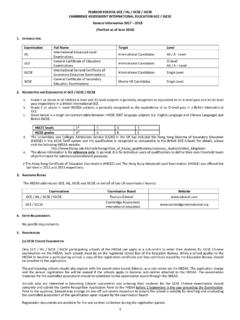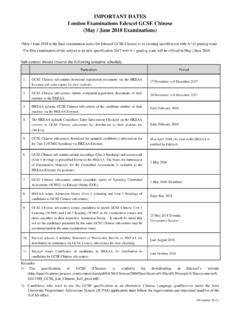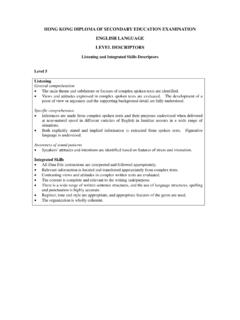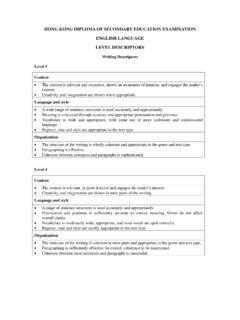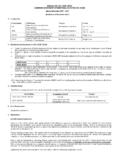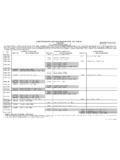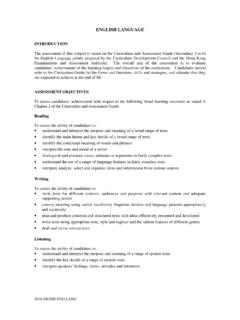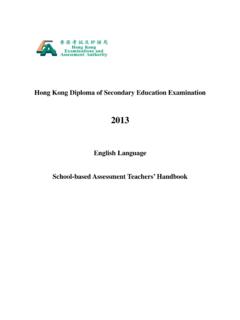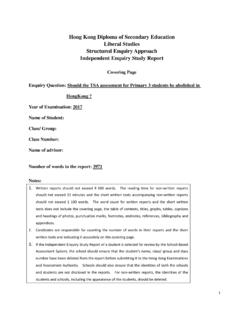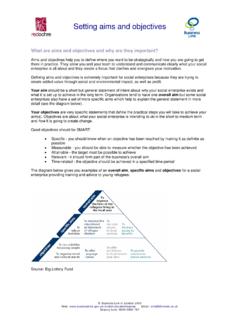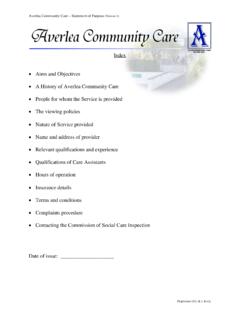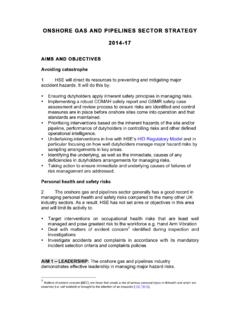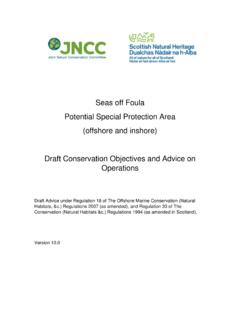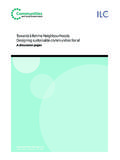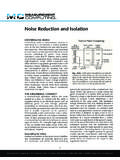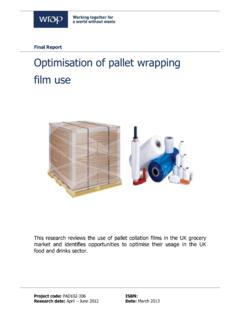Transcription of ADVANCED LEVEL AIMS ASSESSMENT OBJECTIVES
1 2012-AL-PHY. PHYSICS. ADVANCED LEVEL . aims . A course of study based on this Syllabus should : 1. provide a balanced course for further study and give an appreciation of the nature and the importance of physics in daily life;. 2. help candidates to develop interest, motivation and a sense of achievement in their study of physics;. 3. develop an appreciation of the developments in physics and an awareness of the relationship of physics to everyday life, and of the role of the applications of physics in the fields of engineering and technology;. 4. establish a conceptual framework for physics and provide an understanding of its methodology;. 5. encourage a balance between an experimental and a theoretical approach to physics;. 6. develop skills relevant to the application of physics, such as experimental design, experimental technique, problem solving, mathematical analysis, critical appraisal and communication; and 7.
2 To help candidates to acquire a sense of moral and social values and readiness to becoming responsible citizens in a changing world. ASSESSMENT OBJECTIVES . Candidates should acquire the ability to : 1. recall and show understanding of factual knowledge, terminology, definitions, conventions, experimental methods, laws and models;. 2. demonstrate experimental techniques : planning and execution of experiments, analysis and presentation of results and simple treatment of errors;. 3. demonstrate the application of physics knowledge in problem solving and experimental investigation, including qualitative and numerical, theoretical and practical techniques;. 4. communicate by compilation of clear, concise accounts of experimental work and theoretical treatments, including interpretation and transposition of data, and use of models to explain phenomena.
3 5. demonstrate evaluation and judgement by the analysis and ASSESSMENT of situations or data, and decision making on the basis of such judgements. THE EXAMINATION. 2012-AL-PHY. 1. The examination consists of two written papers and a Teacher ASSESSMENT Scheme (TAS). The examination structure and the allocation of marks will be as follows: PAPER 1 3 hours, Structured-type questions 42%. PAPER 2 3 hours, Multiple choice (25%) and essays (18%) 43%. PAPER 3 TAS (compulsory for school candidates) 15%. PAPER 4 1 hour 30 minutes, Practical (for private candidates only) 15%. 2. Paper 1 contains structured-type questions, all of which are to be attempted. Paper 2 consists of two sections, A and B. Section A contains multiple-choice questions and Section B contains essay-type questions, and candidates are required to answer 3 out of 4 questions in this section.
4 3. Paper 3 is a Teacher ASSESSMENT Scheme, which is compulsory for all school candidates. Their practical abilities will be assessed internally by subject teachers. These abilities include the following: (i) demonstrate manipulative skills in carrying out experiments (ii) make accurate observations and measurements (iii) record and present data properly (iv) interpret results and draw conclusions The regulations, guidelines and methods of ASSESSMENT can be found in the Handbook on the A/AS Physics Teacher ASSESSMENT Scheme issued by the Hong Kong Examinations and ASSESSMENT Authority to participating schools. 4. For private candidates, they may opt to sit the practical examination (Paper 4) or to use their previous TAS results to substitute the practical examination. Paper 4 consists of one experiment to test candidates' practical skills and their ability to report on experiments.
5 5. Knowledge of the prescribed experimental work is required, and questions requiring knowledge and understanding of these experiments may be set. 6. A broad knowledge of the Hong Kong Certificate of Education Physics Syllabus is assumed and questions requiring such knowledge may be set. 7. Practical skills expected and mathematical knowledge recommended are listed in appendices to the syllabus. 8. In general questions will be set in SI units. Wherever letter symbols, signs and abbreviations are used, they will follow the recommendations made in the Association for Science Education Report SI units, Signs, Symbols and Abbreviations. 9. The purpose of the examination will be to evaluate understanding rather than factual recall. Where possible, questions requiring simple recall of bookwork' will be avoided.
6 THE SYLLABUS. 2012-AL-PHY. Notes 1. Teachers should note that many of the suggested experiments are very short, and could be used most effectively as quick demonstrations to introduce a topic or start a lesson. Other experiments are long and these should be done by the candidates themselves, wherever possible. 2. The material of the syllabus including descriptions of experiments can be found in many recent A- LEVEL physics textbooks. 3. Subject materials need not be taught in the order given. Section A : Mechanics Syllabus Notes Suggested Experimental Work Statics Friction Qualitative treatment only. E1. Study the effects of the normal Distinction between static (including the force, materials involved and limiting case) and kinetic friction. surface area on the force of friction using a block. Moment of a force Moment of a force as the product of the force and its perpendicular distance from the pivot.
7 Knowledge and use of torques and couples. The principle of moments and its applications in simple balanced situations. Static equilibrium Two-dimensional treatment only. Conditions for equilibrium of forces acting on a point mass and a rigid body. Centre of gravity and its experimental E2. Determination of of a body of determination. Stability (very briefly). any shape. Syllabus Notes Suggested Experimental Work 2012-AL-PHY Kinematics Uniformly accelerated motion in Displacement, velocity and acceleration in one dimension one dimension. Graphical representation. Knowledge and use of equations of uniformly accelerated motion. Dynamics Newton's laws of motion Knowledge and use of Newton's laws of motion. Principle of conservation of Use of the impulse-momentum equation linear momentum in one and Ft = mv mu.
8 Consistency of Newton's two dimensions third law with conservation of linear momentum. Distinction between elastic and inelastic collisions. Coefficient of restitution not required. Principle of measuring inertial mass using mx/my = vy/ vx for explosive separation of two masses initially at rest. Examples of conservation of linear momentum to include recoil of rifles, collision of particles with helium atoms (analysis of cloud chamber photographs). Syllabus Notes Suggested Experimental Work 2012-AL-PHY Work, energy and power Understanding of the relationship between work and different forms of energy. Work as transfer of energy defined by W = Fs cos . Knowledge and use of change of gravitational potential energy, mg h. Kinetic energy= mv2 derived from the energy transferred. Power as the rate at which energy is transferred.
9 Knowledge and use of P = F v cos . Efficiency. Law of conservation of energy Knowledge and use of the transformations between potential energy and kinetic energy. Projectile Motion Resolution of velocities. Independence of E3. Demonstration of the independence horizontal and vertical motions for of horizontal and vertical motions projectiles. Simple calculations. Terminal using the monkey and hunter kit. velocity ( of a parachutist). Circular motion Angular velocity (rad s-1). Linear velocity mv 2. E4. Experimental test of F = by v = r. Centripetal acceleration a = v2/r and r centripetal force. Examples to include whirling a rubber bung. vehicles rounding bends (with and without banking), aircraft turning in flight, looping the loop, the centrifuge (qualitatively). Gravitation 2012-AL-PHY. Gravitational force between Newton's law of universal gravitation for masses point masses and its extension to spherically symmetrical bodies (proof not required).
10 Method of measuring the gravitational constant G is not required. Field strength g g taken as gravitational force per unit mass. M. Knowledge and use of g = G. r2. (assuming the Earth to be a sphere of uniform density). Calculation of the Earth's mass. Mm Gravitational potential energy U Derivation of U = G considering r the gravitational potential energy at infinity to be zero. Velocity of escape and launching of satellites. Circular orbits (including parking orbits). Weightlessness. Planetary motion Quantitative treatment of circular orbits only. Knowledge and use of Kepler's laws. Consistency of Kepler's law (r3/T2 =. constant) with Newton's law of gravitation. Oscillation 2012-AL-PHY. Simple harmonic motion Isochronous oscillation. Acceleration E5. Investigation of the extension and a = - 2x, displacement x = A sin t vibrations of a loaded spring.
